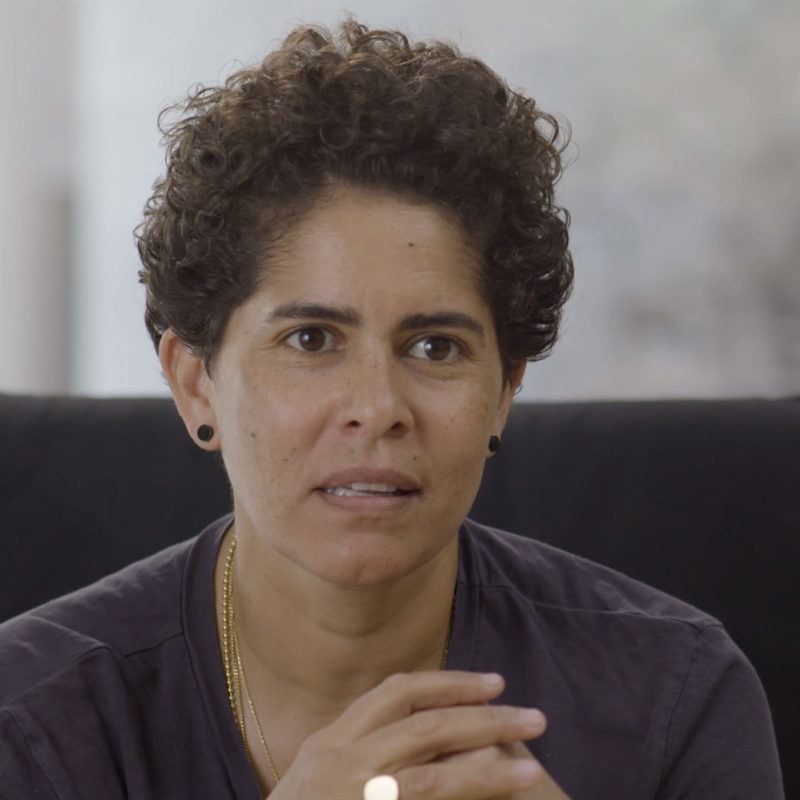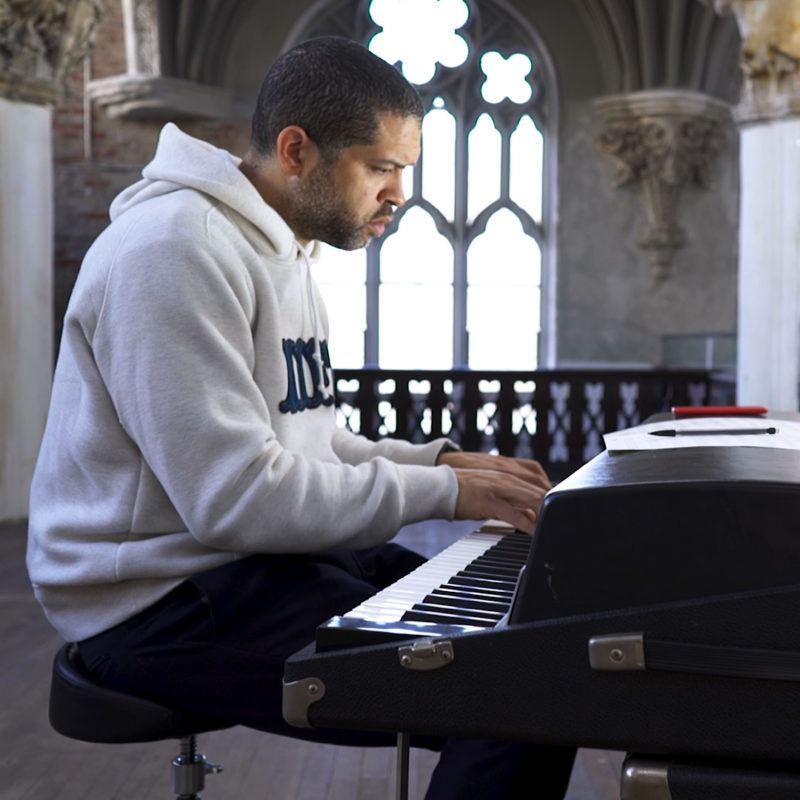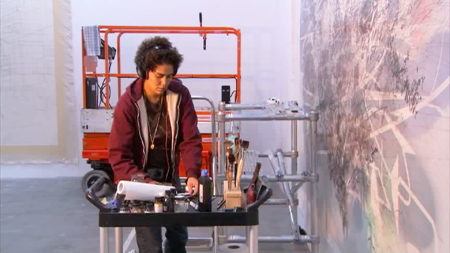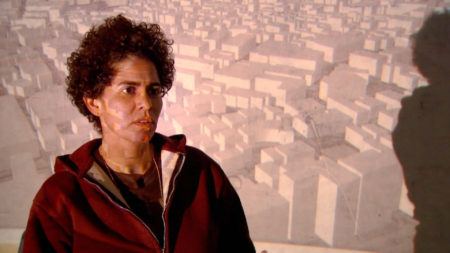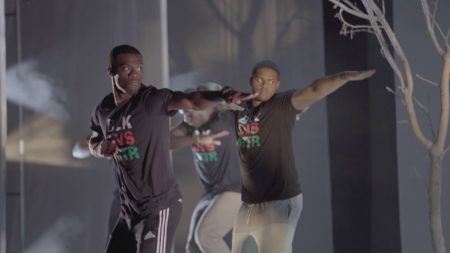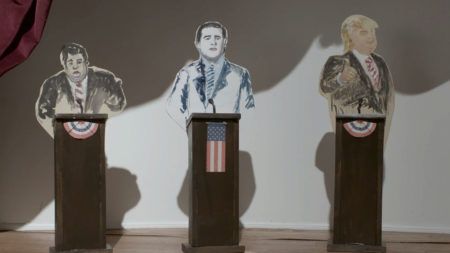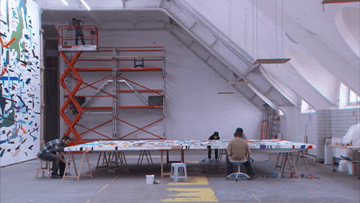Continue playing
(Time remaining: )
Play from beginning
Continue playing "{{ controller.videos[controller.getVideo(controller.currentVideo)].segmentParentTitle}}"
{{controller.videos[controller.getVideo(controller.currentVideo)].title}} has ended.
Politicized LandscapesJulie Mehretu
Shown working on two site-specific paintings for the San Francisco Museum of Modern Art (SFMOMA), Julie Mehretu recontextualizes the history of American landscape painting by merging its sublime imagery with the harsh realities not depicted. “What does it mean to paint a landscape and be an artist in this political moment?” she asks from the decommissioned Harlem church used as her studio for the project.
Referencing the ways that landscapes have been politicized through historical events—from the violent expansion of the American West, colonialism, war, and abolition, through to more recent race riots and social protests—Mehretu began by combining photographs from these events with nineteenth-century landscape paintings. Abstracting and digitizing the blended forms, she printed the resulting images on two monumental canvases, each spanning more than eight hundred square feet. Over these underpaintings, Mehretu adds gestural, calligraphic brush strokes before screen printing an additional, complicating layer of pixelated images. Collaborator Jason Moran, a composer and jazz pianist, joins Mehretu in the studio to create a musical arrangement inspired by her improvisational process of markings and erasure.
Through their respective practices, the two artists create new visual and auditory languages in the hopes of processing the complex history that brought us to our present moment. As Mehretu explains, the paintings become “visual neologisms,” that combine the work and inventions of past artists, “to address when language isn’t enough.”
The paintings, titled “HOWL, eon (I, II)” (2017), are currently on view in the SFMOMA atrium.
Credits
Producer: Ian Forster. Interview: Ian Forster. Editor: Morgan Riles. Camera: John Marton. Sound: Michael Kelly. Artwork Courtesy: Julie Mehretu, Marian Goodman Gallery & SFMOMA. Music: Jason Moran & Jamo Publishing (SESAC). Additional Footage Courtesy: SFMOMA. Special Thanks: Sarah Rentz, Reynolda House Museum of American Art, Smithsonian American Art Museum & Damien Young.
Extended Play is supported, in part, by the New York City Department of Cultural Affairs in partnership with the City Council; Art21 Contemporary Council; and by individual contributors.
Closed captionsAvailable in English, German, Romanian, Italian, Japanese, Korean, Chinese, Italian
Through the Art21 Translation Project, multilingual audiences from around the globe can contribute translations, making Art21 films more accessible worldwide. Translate this video now.
Interested in showing this film in an exhibition or public screening? To license this video please visit Licensing & Reproduction.
Julie Mehretu’s paintings and drawings refer to elements of mapping and architecture, achieving a calligraphic complexity that resembles turbulent atmospheres and dense social networks. Architectural renderings and aerial views of urban grids enter the work as fragments, losing their real-world specificity and challenging narrow geographic and cultural readings. The paintings’ wax-like surfaces—built up over weeks and months in thin translucent layers—have a luminous warmth and spatial depth. Her works engage the history of nonobjective art—from Constructivism to Futurism—posing contemporary questions about the relationship between utopian impulses and abstraction.
An innovative and genre-crossing pianist, composer, and bandleader, Jason Moran has a venerable career as a recording and performing musician, marrying classical, blues, and jazz with hip-hop, funk, and rock in ways that continually expand genre boundaries. Moran has collaborated with jazz masters such as Charles Lloyd, Bill Frisell, and the late Sam Rivers, as well as the drummer Nasheet Waits and the bassist Tarus Mateen in the trio, The Bandwagon. Moran also collaborates extensively with a broad range of visual artists, including Adrian Piper, Joan Jonas, Glenn Ligon, Stan Douglas, Adam Pendleton, Lorna Simpson, Kara Walker, and Julie Mehretu.
Julie Mehretu
Julie Mehretu
“I don’t think it’s possible for me to ever think about the American landscape without thinking about the colonial history—and the colonial violence—of that narrative.”
Julie Mehretu
America Now
How are artists answering the question: What is America today? Historical markers continue to shape the discourse of the new-normal and artists are responding with powerful works that are representative of the times. This playlist showcases how artists are responding to the dynamic nature of the United States and its parallels.
Drawn from Politics
Carrie Mae Weems
Eleanor Antin
Tania Bruguera
Julie Mehretu & the Problem of Shooting Big
Art21 Director of Production Nick Ravich discusses the difficulty of shooting works as large-scale as Julie Mehretu’s, and offers helpful tips for fellow documentarians.

